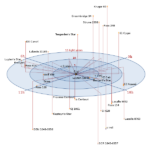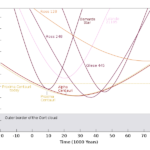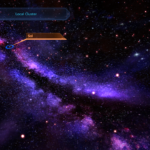Here are the solar systems and brown dwarfs closest to our home around the Sun. All of them are within 5 parsecs (16.3 light-years). These systems contain a total of 60 hydrogen-fusing stars (of which 50 are red dwarfs), 13 brown dwarfs, and 4 white dwarfs. Despite the relative proximity of these objects to Earth, only nine of them have an apparent magnitude less than 6.5, which means only about 12% of these objects can be observed with the naked eye. Besides the Sun, only three are first-magnitude stars: Alpha Centauri, Sirius, and Procyon. All of these objects are located in the Local Bubble, a region within the Orion–Cygnus Arm of the Milky Way.
Solar Systems Directory:
- 2MASS J154042.42-510135.7: details TBA
- 61 Cygni: _
- AD Leonis: _
- Alpha Centauri: _
- Barnard’s Star: _
- DX Cancri: _
- DEN 0255-4700: _
- DEN 1048-3956: _
- DENIS J081730.0-615520
- EZ Aquarii: _
- Epsilon Eridani: _
- Epsilon Indi: _
- G 208-44: _
- G 208-45: _
- GJ 1002: _
- GJ 1005: _
- GJ 1061: _
- GJ 1245: _
- Gliese 1: _
- Gliese 412: _
- Gliese 674: _
- Gliese 687: _
- Gliese 832: _
- Gliese 876: _
- Groombridge 34: _
- Groombridge 1618: _
- Kapteyn’s Star: _
- Kruger 60: _
- LHS 288: _
- LHS 292: _
- LP 145-141: _
- Lacaille 8760: _
- Lacaille 9352: _
- Lalande 21185: _
- Luhman 16: _
- Luyten 726-8: _
- Luyten’s Star: _
- Procyon: _
- Ross 128: _
- Ross 154: _
- Ross 248: _
- Ross 614: _
- SCR 1845-6357: _
- Sirius: _
- Struve 2398: _
- Sun / Sol solar-system: home of humanity prior to the 24th century A.D., Earth-time
- Tau Ceti: _
- Teegarden’s Star: _
- UPGS 0722-05: _
- Van Maanen’s Star: _
- WISE 0350-5658: _
- WISE 0535-7500: _
- WISE 0855−0714: _
- WISE 1506+7027: _
- Wolf 359: _
- Wolf 424: _
- Wolf 1061: _
- YZ Ceti: _
Details here.
–




